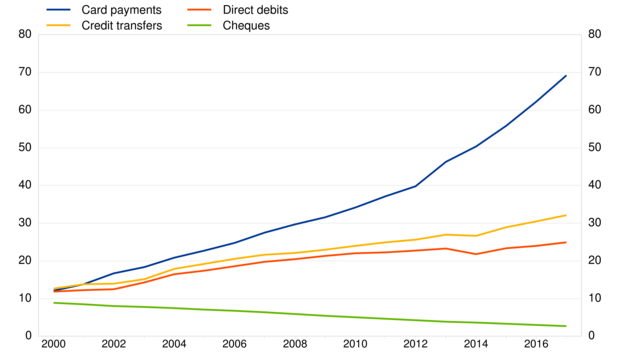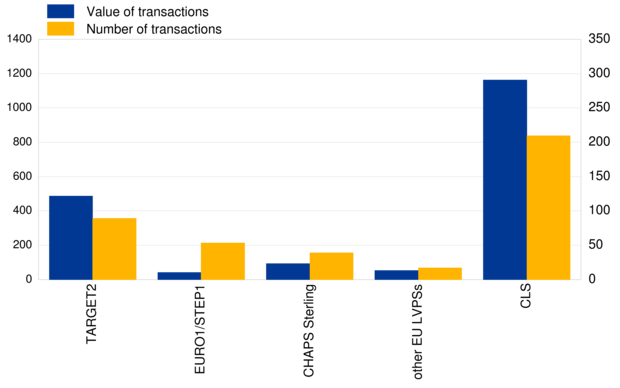- Press release
- 14 September 2018
Payments statistics: 2017
- The total number of non-cash payments in the EU increased by 7.9% to 134 billion in 2017 compared with the previous year.
- Card payments accounted for 52% of the total number of non-cash payments in the EU, while credit transfers accounted for 24% and direct debits for 19%.
- The number of payment cards issued (812 million) represented around 1.6 payment cards per EU inhabitant.
- Around 57 billion transactions were processed by retail payment systems in the EU with an amount of €44.0 trillion.
The European Central Bank (ECB) has today published the 2017 statistics on non-cash payments, which comprise indicators on access to and use of payment services and terminals by the public, as well as volumes and values of transactions processed through payment systems. Statistics are published for each EU Member State, in addition to EU and euro area aggregates and comparative data.
Payment services[1]
The total number of non-cash payments in the EU, comprising all types of payment services[2], increased by 7.9% to 134.0 billion in 2017 compared with the previous year. Card payments accounted for 52% of all transactions, while credit transfers accounted for 24% and direct debits for 19%.
The number of credit transfers within the EU increased in 2017 by 5.5% to 32.1 billion. The importance of paper-based transactions continued to decrease, with the ratio of paper-based transactions to transactions initiated electronically standing at around one to ten.
The number of cards with a payment function in the EU increased in 2017 by 2.0% to 812 million. With a total EU population of 513 million, this represented around 1.6 payment cards per EU inhabitant. The number of card transactions rose by 11.2% to 69.2 billion, with a total value of €3.1 trillion. This corresponds to an average value of around €44 per card transaction. Chart 1 below shows the use of the main payment services from 2000 to 2017.
The relative importance of each of the main payment services continued to vary widely across EU countries in 2017 (see Annex).
In 2017, the total number of automated teller machines (ATMs) in the EU decreased by 1.0% to 0.43 million, while the number of point of sale (POS) terminals increased by 9.9% to 13.5 million.
Use of the main payment services in the EU
(number of transactions per year in billions, estimated) Source: ECB.Note: Data have been partially estimated for periods prior to 2010, as methodological changes were implemented in previous years and some corresponding data are not available. The historical estimation done by the ECB ensures comparability of figures over the entire period. Statistics are also collected on e-money payments and other payment services, which accounted for 3.7% of the total number of EU transactions in 2017.
Retail payment systems
Retail payment systems in the EU handle mainly payments that are made by the public, with a relatively low value, high volume, and limited time-criticality.
In 2017, 43 retail payment systems existed within the EU as a whole. During the year, around 57 billion transactions were processed by those systems with an amount of €44.0 trillion. 22 of these systems were located in the euro area, where they processed almost 42 billion transactions in 2017 (i.e. 73% of the EU total) with a value amounting to €31.6 trillion (i.e. 72% of the EU total).[3]
There continues to be a notable degree of concentration in EU retail payment systems in 2017. The four largest systems in terms of number of transactions (CORE in France, STEP2[4], BACS in the United Kingdom and RPS in Germany) processed 60% of the volume and 64% of the value of all transactions processed by EU retail payment systems. Chart 2 shows the number and value of transactions processed by EU retail payment systems in 2017.
Retail payment systems in the EU in 2017
(value of transactions in EUR trillions (left-hand scale) and number of transactions in billions (right-hand scale)) Source: ECB.
Large-value payment systems
Large-value payment systems (LVPSs) are designed primarily to process urgent or large-value interbank payments, but some of them also settle a large number of retail payments. During 2017, 12 systems settled 842 million payments with a total value of €702 trillion in the EU.[5] The two main LVPSs in the euro area (TARGET2 and EURO1/STEP1)[6] settled 143 million transactions amounting to €528 trillion in 2017, i.e. 75% of the total value. In the non-euro area EU countries, CHAPS Sterling[7] in the United Kingdom is the largest LVPS in terms of value and number of transactions.
Outside the EU, Continuous Linked Settlement[8] (CLS) is the most important large value payment system processing, inter alia, euro and other EU currencies. CLS (all currencies) settled 198 million transactions with a value of €1193 trillion in 2017. Chart 3 below shows the number and value of transactions processed by LVPSs in 2017.
Large-value payment systems in 2017
(value of transactions in EUR trillions (left-hand scale) and number of transactions in millions (right-hand scale)) Source: ECB.Note: Other EU LVPSs exclude CERTIS, which act as both LVPSs and retail systems.
Annex
Relative importance of the main payment instruments in the EU (2017)For media queries, please contact Stefan Ruhkamp, tel.: +49 69 1344 5057.
Notes:
- The full set of payment statistics can be downloaded from the Statistical Data Warehouse (SDW). The "Reports" section of the SDW also contains pre-formatted tables with payment statistics for the last five years. The data are presented in the same format as in the former "Blue Book Addendum". For detailed methodological information, including a list of all data definitions, please refer to the "Statistics" section of the ECB's website.
- As a result of the progressive implementation of the Single Euro Payments Area (SEPA) and other developments in the payments market in Europe, the methodological and reporting framework for payments statistics has been enhanced as of the reference year 2014. The new requirements are laid down in the Regulation on payments statistics (ECB/2013/43) and in the Guideline on monetary and financial statistics (recast) (ECB/2014/15). A background noteavailable on the ECB's website, describes the changes in more detail.
- In addition to annual payments statistics for 2017, this press release incorporates minor revisions to data for previous periods. The hyperlinks in the press release are dynamic; thus, the data might slightly change with the next annual release due to revisions. Unless otherwise indicated, statistics referring to euro area cover the EU Member States that had adopted the euro at the time to which the data relate.
- [1]SEPA instruments are included in the respective categories. Information on the SEPA instruments can be found on the ECB's website (http://www.ecb.europa.eu/paym/sepa/html/index.en.html).
- [2]Including credit transfers, direct debits, card payments with cards issued by resident payment service providers, e-money payments, cheques and other payment services.
- [3]The figures for one Cypriot payment system are excluded from the euro area and EU aggregates due to confidentiality.
- [4]STEP2 is a pan-European automated clearing house for retail payments in euro operated by EBA CLEARING.
- [5]Among the LVPSs that also process retail payments, CERTIS - a Czech Republic system - is the main contributor in terms of number of transactions to the EU aggregate figure, with 603 million. In terms of value, CERTIS settled €17.4 trillion during 2016.
- [6]TARGET2 is the second-generation Trans-European Automated Real-time Gross settlement Express Transfer system. It is operated by the Eurosystem and settles payments in euro in central bank money.EURO1/STEP1 is an EU-wide multilateral net large-value payment system for euro payments operated by EBA CLEARING. Payments are processed in EURO1 throughout the day and final balances are settled at the end of the day in TARGET2.
- [7]CHAPS Sterling handles sterling-denominated interbank payments and it settled 39 million transactions amounting to €92.2 trillion in 2016.
- [8]CLS is a worldwide clearing and settlement system that settles FX transactions on a payment-versus-payment basis.
European Central Bank
Directorate General Communications
- Sonnemannstrasse 20
- 60314 Frankfurt am Main, Germany
- +49 69 1344 7455
- media@ecb.europa.eu
Reproduction is permitted provided that the source is acknowledged.
Media contacts

